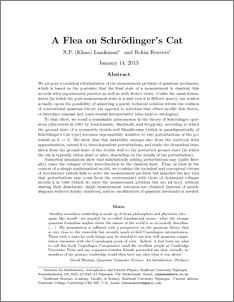Landsman, Nicolaas P. and Reuvers, Robin
(2012)
A Flea on Schroedinger's Cat.
[Preprint]
This is the latest version of this item.
![[img]](https://philsci-archive.pitt.edu/style/images/fileicons/application_pdf.png)  Preview |
|
PDF (31 pages, color online)
Catresubmission.pdf
- Accepted Version
Download (701kB)
|
Abstract
We propose a technical reformulation of the measurement problem of quantum mechanics, which is based on the postulate that the final state of a measurement is classical; this accords with experimental practice as well as with Bohr's views. Unlike the usual formulation (in which the post-measurement state is a a unit vector in Hilbert space, such as a wave-function), our version actually admits a purely technical solution within the confines of conventional quantum theory (as opposed to solutions that either modify this theory, or introduce unusual and controversial interpretative rules and/or ontologies).
To that effect, we recall a remarkable phenomenon in the theory of Schroedinger operators (discovered in 1981 by Jona-Lasinio, Martinelli, and Scoppola), according to which the ground state of a symmetric double-well Hamiltonian (which is paradigmatically of Schroedinger's Cat type) becomes exponentially sensitive to tiny perturbations of the potential as h -> 0. We show that this instability emerges also from the textbook WKB approximation, extend it to time-dependent perturbations, and study the dynamical transition from the ground state of the double well to the perturbed ground state (in which the cat is typically either dead or alive, depending on the details of the perturbation).
Numerical simulations show that, in an individual experiment, certain (especially adiabatically rising) perturbations may (quite literally) cause the collapse of the wavefunction in the classical limit. Thus we combine the technical and conceptual virtues of dynamical collapse models a la GRW (which do solve the measurement problem) with those of decoherence (in that our perturbations come from the environment) without sharing their drawbacks: although single measurement outcomes are obtained (instead of merely diagonal reduced density matrices), no modification of quantum mechanics is needed.
Available Versions of this Item
Monthly Views for the past 3 years
Monthly Downloads for the past 3 years
Plum Analytics
Actions (login required)
 |
View Item |



